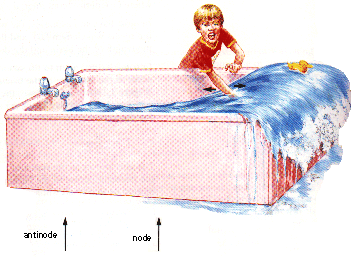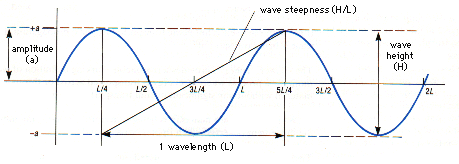

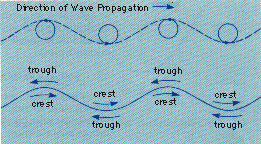
|
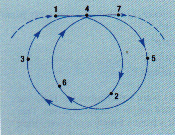 |
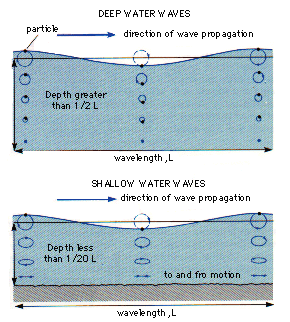 |
|
- where the acceleration due to gravity g is 9.8 m/sec2; L=wavelength
- where the acceleration due to gravity g is 9.8 m/sec2 and d=depth
- where tanh is a mathematical function known as the hyperbolic tangent and L=wavelength; here you would need to know the wavelength and depth and have access to hyperbolic tangent tables
where T=period and g=9.8 m/sec2 (or 32 ft/sec2) -- the equation can be simplified to L = 1.56 T2 (for meters) or 5.12 T2 (for feet)
- deep water waves that have the greatest wavelengths and longest periods, travel the fastest and are the first to arrive in regions distant from the storm which generated them
- if you toss a stone into a pond, a band of ripples is produced -- this band gets wider with increasing distance from the original disturbance and the ripples of greater wavelength progressively outdistance those with shorter wavelengths (they outrun the shorter ones)
- this is dispersion (separation of waves by their differing rates of travel) and it produces swells
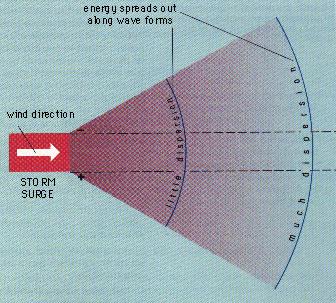
- progressive groups of swell with the same origin and wavelength are called wave trains
- the leading wave in a train is drained of energy (because it must set up the circular motion), but after the wave train passes, it leaves behind enough energy to generate a new wave
- as a wave advances through the group, each wave moves through the group to die out at the front -- the distance traveled by each individual wave as it travels from rear to front of the group is twice that traveled by the group as a whole
- hence the wave speed is 2 x the group speed or the group speed is 1/2 the wave speed
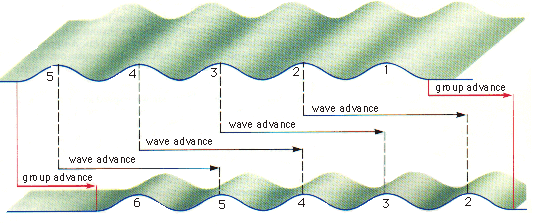
- it is inevitable that swells from different disturbances will run together -- when this happens, they will interfere with each other
- when crests of two wave trains coincide, the amplitudes are added (constructive interference)
- when the wave trains are out of phase--the crests coincide with the troughs -- the amplitudes cancel out (destructive interference); get mixed interference when crests and troughs do not coincide
- thus, the wave trains interact, lose their individual identities and form a new group of waves separated by regions free from waves
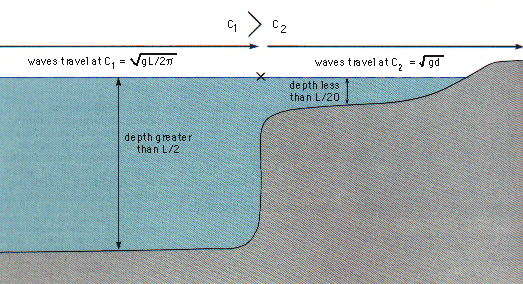
- interaction with the bottom slows the wave, but waves behind this first wave continue at their original speed -- thus period remains unchanged while wavelength decreases; the wave then becomes too high for its decreasing wavelength
- depth continues to decrease and the crest of the wave breaks -- the turbulent mass of water rushing shoreward after the break is known as surf and the surf zone is that region between the shore and the breaking waves
- there are 4 types of breaking waves:
- spilling breakers -- the crest moves forward faster than the wave as a whole; foam eventually covers the leading face of the wave; characteristically found on a gently sloping shoreline
- plunging breakers -- the crest curls over and plunges downward with considerable force
- collapsing breakers -- similar to plunging breakers, but instead of the crest curling over, it collapses; occur on beaches with moderately steep slopes
- surging breakers -- crests remain relatively unbroken as the waves slide up the steep beach
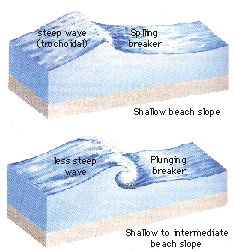 |
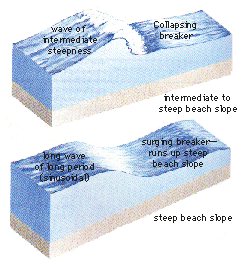 |
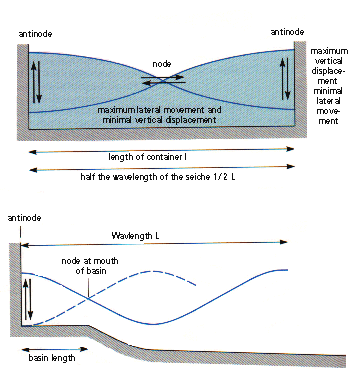
- but if a basin is open at one end, it is possible for a node to occur at the entrance of the basin and an antinode at the landward end; water levels will then rhythmically oscillate between node and antinode and will result in damage on the landward side
